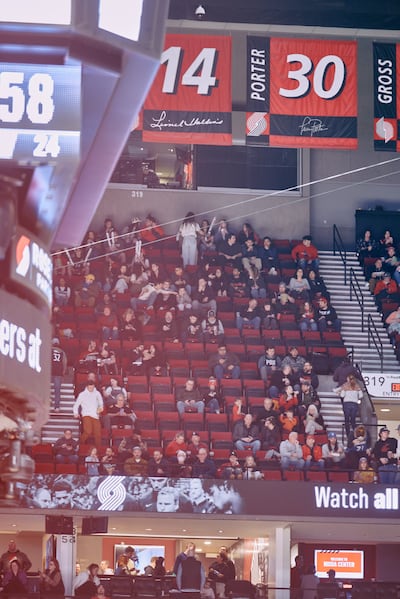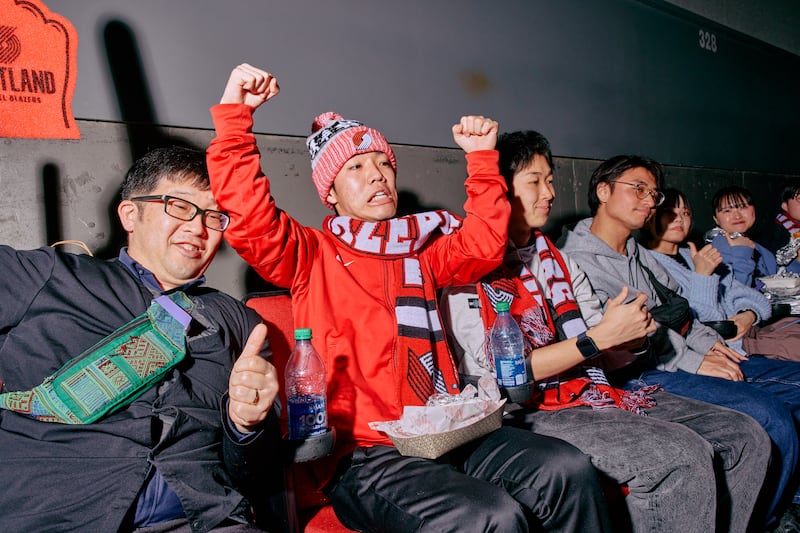Two things can be said about the Trail Blazers right now.
1. They haven’t been this bad for this long in nearly 20 years. Maybe 50 years.
2. They won’t be truly competitive until they find at least one player with All-NBA-level talent.
This isn’t hyperbole. The Blazers won 81 games cumulatively over the past three seasons. The only worse stretch, since the days of LaRue Martin and Sidney Wicks at least, was an 80-win dip spanning 2004 to 2007.
The mid-2000s Blazers were already turning things around by the third year of their rebuild after finding the two best players in the 2006 draft, Brandon Roy and LaMarcus Aldridge, and jettisoning Zach Randolph during the 2007 offseason. You know the rest.
The same cannot be said about the 2024 Blazers. None of the young players on the current roster has had the immediate impact of Roy and Aldridge in their inaugural seasons. That’s a problem: NBA teams can’t compete without stars. In the past 10 years, 39 of the 40 teams that have advanced to the NBA conference finals have had at least one All-NBA player. Most have had at least a second All-Star as a sidekick. The one exception to the All-NBA rule, the 2015 Atlanta Hawks, fielded four All-Star reserves.
That leaves general manager Joe Cronin in a tough position. Cronin has used lottery picks on Scoot Henderson, Shaedon Sharpe, and Donovan Clingan over the past three summers in search of a star. It’s unclear if he’s going to find one with the current trio.
Henderson’s rookie campaign suffered fits and starts—his athleticism was slow to translate to NBA speed and his pick-and-roll acumen was offset by turnovers and fouls. Conversely, Sharpe flashed high-ceiling potential from jump (he certainly caught our attention), but injuries derailed a sophomore campaign. Neither was selected for the league’s all-rookie team.

It’s certainly possible that Henderson or Sharpe rebounds this year and turns into a star. But the reality is that neither player has the rookie of the year bona fides that Roy carried into the 2007-08 season. It’ll be at least one more year before we have any real idea if Scoot or Shaedon can shine brighter.
That leaves Clingan. He projects to be a strong defender but a mostly complementary player on offense. He’s a favorite among draft modelers. There’s certainly some potential here. But he’s likely not bringing the sure-fire starpower that players like Victor Wembanyama or Paolo Banchero flashed during their rookie seasons. It’ll probably be at least a year until we know if Clingan could end up on Rudy Gobert’s level.
So how does Cronin build a team while waiting a year (at least) for a star to (maybe) emerge?
There’s no easy answer here. The three best players on the roster—Deandre Ayton, Anfernee Simons, and Jerami Grant—are all above-average NBA starters who could play a role on a championship team. Ayton was the starting center for the Suns in the 2021 Finals. They’re all on decent contracts.

It’s also becoming increasingly unlikely that Ayton, Grant or Simons will themselves become All-Stars, which creates questions. Ultimately, veterans of their skill levels will need to complement the All-Stars in the starting lineup, or be traded to balance the roster. Is it possible to assess Simons’ value to the franchise before knowing how good Henderson and Sharpe will be? Will Clingan and Ayton both merit a starting role? Is there room for Grant’s ball-dominant style alongside a high-scoring guard, or does his rebounding weakness cancel out the extra points? There’s a significant risk of trading the “wrong” talented veteran, and that risk has to be weighed against clearing room to let the young prospects sink or swim.
Thus far, the Blazers have not been forced to make a long-term decision about Simons, Grant or Ayton. And there’s still time—Ayton has only been with the team for one season, Grant for two seasons. Their continued presence, however, eventually becomes a reminder that there’s no rising star player forcing a competition for touches and minutes. We all loved watching Malcolm Brogdon win some games last year, but the final standings weren’t pretty. The NBA is harsh.
Outside of the lottery picks and veterans, the Blazers have been searching for role players with the versatility to guard multiple positions both on and off the ball. Toumani Camara, seemingly a trade throw-in, looked like a legitimate NBA wing in his rookie season. Cronin turned Brogdon and a couple of draft picks into Deni Avdija on draft night—a possible long-term solution at small forward on a team-friendly contract (see below). Those two, plus Clingan, have the look of a fearsome defensive frontcourt.
Unfortunately, any answers provided by Camara, Avdija and the rest of the prospects on the roster are still overshadowed by larger questions. Despite their best efforts, the Blazers thus far seem to be building a roster from the bench up. Stumbling across solid role players is nice, but until a star rises, the Blazers’ ship will remain rudderless.

The Blazers and the 2024 NBA draft
When the dust settled on this year’s draft, Cronin had, cumulatively, created three effects: (1) Drafting Clingan with the No. 7 pick, (2) acquiring Avdija for the No. 14 pick, a future first-round pick, and two future second-round picks, and (3) walking in with two second-round picks in this year’s draft, walking out with three second-round picks in future drafts and some cash.
Avdija projects to be a long-term starting forward, particularly if his jump shot keeps improving and is a highlight machine. He’s also on a team-friendly contract. Converting one of this year’s first-round picks into Avdija and pushing the second-round picks into future years also created roster space. The deep bench is filled with young prospects so buying time to use the second-rounders in the future was prudent. They’ve already capitalized on the roster space by exercising the team option on Dalano Banton’s contract for this season.
One thing to watch is that the Blazers cumulatively used four draft picks to acquire Avdija (No. 14 this year, a first-rounder in 2029, two future second-rounders). He will hopefully, or even likely, justify the investment.
The downside is that the Blazers don’t have a huge stash of future draft picks. One incoming first-round pick in 2029 is canceled out by an outgoing obligation to the Chicago Bulls at some point in the near future. Which leaves them with pick swaps with the Bucks in 2028 and 2030 as their only cumulative incoming first-round bonuses.
That puts the Blazers at a competitive disadvantage if an emerging superstar ends up on the trade market, like Shai Gilgeous-Alexander did a couple years ago. Other rebuilding teams who have accumulated multiple future first-round picks, like the Jazz and Spurs, will have an easier time putting together splashy trade packages. Avdija may certainly justify this tradeoff; he’s a real player and I’m worrying about a hypothetical trade that doesn’t yet exist, after all. But with every diminishment of future options, there’s more riding on the incumbent prospects.
Swapping out Brogdon and the salary obligation of a second first-round pick (No. 14) for Avdija bumped the Blazers under the luxury tax line, according to Spotrac.
